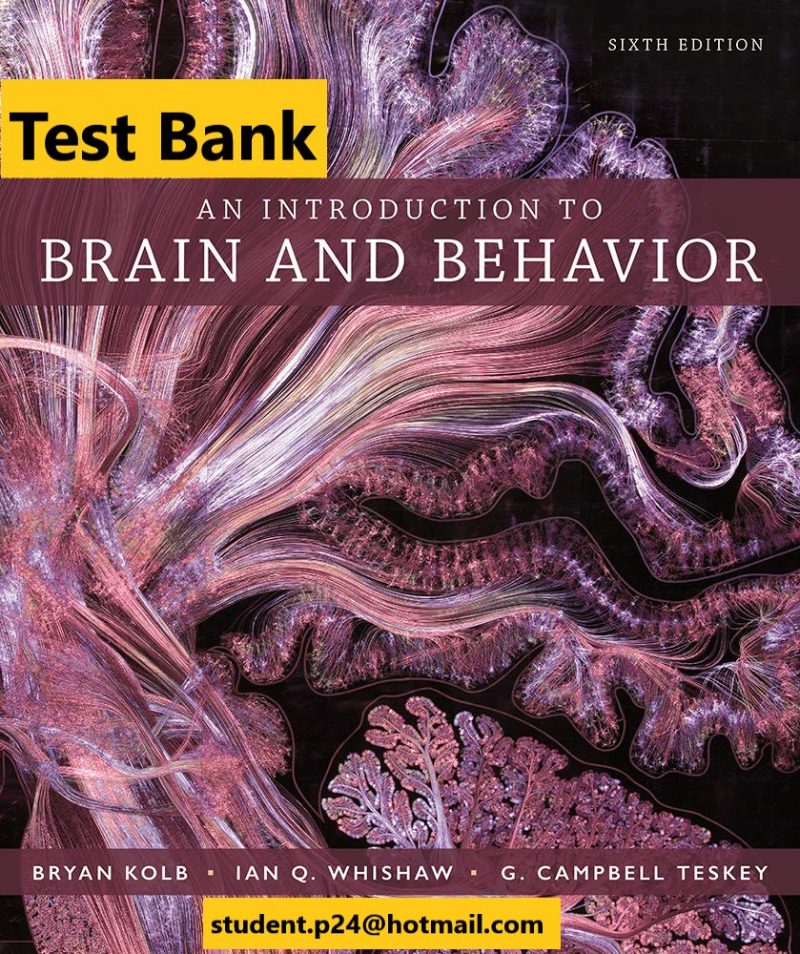An Introduction to Brain and Behavior 6th Kolb Test Bank
Test Bank for An Introduction to Brain and Behavior 6th Bryan Kolb , Ian Q. Whishaw , G. Campbell Teskey Test Bank

An Introduction to Brain and Behavior 6th Bryan Kolb , Ian Q. Whishaw , G. Campbell Teskey Test Bank
Test Bank
Product details
- Publisher: Worth Pub; 6 edition (18 January 2019)
- Language: English
- ISBN-10: 1319107370
- ISBN-13: 978-1319107376
An Introduction to Brain and Behavior 6th Kolb Test Bank
its the TEST BANK
To request it .. Please contact us via e-mail
[email protected]
or you can use form contact by this link :
https://buy-testbank.com/contact-us/
Example:
Hi ,
book name :
Introduction to Brain and Behavior
Sixth Edition ©2019
IMPORTANT **
You will receive a response from us, just by this email ..
[email protected]
or
[email protected]
any other email address , it not us.
DESCRIPTION
Introduction to Brain and Behavior
Sixth Edition ©2019
The new edition continues the Brain and Behavior tradition of incorporating the latest research throughout the book. Revisions include new material discussing current research on genetic mosaics and modification, including transgenic techniques and optogenetic techniques, neurotransmitters, hormones, brain development in adolescence, psychobiotics, color perception, and biorhythms, as well as updates to the discussion of specific disorders to reflect the current state of understanding, including Parkinson’s disease, Alzheimer’s disease, depression and drug dependency, sleep disorders, schizophrenia, glaucoma, and abnormal development related to prenatal experience.
.
NEW TO THIS EDITION
The online LaunchPad platform includes a host of new activities and resources crafted by a team of instructors under the direct guidance of the authors. These activities are the perfect way to illustrate key concepts in the course and assess students’ understanding. In addition, the LearningCurve adaptive quizzing system offers students an efficient and effective way to study and identify the topics they understand least, so they can better prepare for exams. Video activities, a newsfeed of scientific articles, and other resources make this a robust supplement for any behavioral neuroscience course.
TABLE OF CONTENTS
Table of Contents
Chapter 1 What Are the Origins of Brain and Behavior?
Chapter 2 What Is the Nervous System’s Functional Anatomy?
Chapter 3 What Are the Nervous System’s Functional Units?
Chapter 4 How Do Neurons Use Electrical Signals to Transmit Information?
Chapter 5 How Do Neurons Communicate and Adapt?
Chapter 6 How Do Drugs and Hormones Influence the Brain and Behavior?
Chapter 7 How Do We Study the Brain’s Structures and Functions?
Chapter 8 How Does the Nervous System Develop and Adapt?
Chapter 9 How Do We Sense, Perceive, and See the World?
Chapter 10 How Do We Hear, Speak, and Make Music?
Chapter 11 How Does the Nervous System Respond to Stimulation and Produce Movement?
Chapter 12 What Causes Emotional and Motivated Behavior?
Chapter 13 Why Do We Sleep and Dream?
Chapter 14 How Do We Learn and Remember?
Chapter 15 How Does the Brain Think?
Chapter 16 What Happens When the Brain Misbehaves?
About the Author

Bryan Kolb

Ian Q. Whishaw

G. Campbell Teskey
, Also .. you can check our full list there :
list of Solution manual and Test Bank Part 1
and
list of Solution manual and Test Bank Part 2
and
list of Solution manual and Test Bank Part 3
————————————————————————————
What is SM, TB , IM ?
· What is the Test Bank (TB)?
An ever-expanding collection of previously administered exams, quizzes, and other assessment measures in a wide range of courses made available for current students as study aids.
Why should I use previously administered tests to study?
* become familiar with how material will be tested
* see the format of the test
* practice test-taking skills
* simulate a timed exam
* gain more experience with course content
· What is a SOLUTION MANUAL (SM)?
A Solutions Manual contains all the answers to the questions in the book with detailed explanations and examples.
· What is an INSTRUCTOR’S SOLUTION MANUAL (ISM) OR INSTURCTOR’S MANUAL (IM)?
An Instructor’s Manual is the guide that your teacher may use when making lesson plans and contain extra questions and answers, lab assignments, and more.
Note:
All solutions manual and Test Banks be in soft copy [Adobe Acrobat Reader (PDF )or Word format .Docx]
Best wishes,
Student Saver Team ,
================